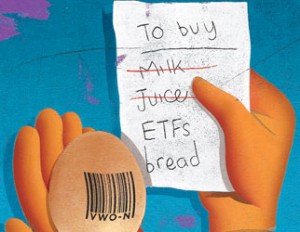Key portfolio ingredients
Bruce Sellery says building a portfolio with ETFs and index funds is as easy as making a butter tart—only healthier.
Advertisement
Bruce Sellery says building a portfolio with ETFs and index funds is as easy as making a butter tart—only healthier.
 Question
I want to get into index funds but don’t know which ones to buy. Any advice?
Answer
I explained the difference between index funds and ETFs in my last blog post and I’ll now go over some specific product options. But first, one important note of caution: before you decide which products to buy, you need to be clear on your investment objective and have a basic plan. Are you buying these index funds for your retirement or to save for your kids’ education? The answer will impact the plan, and therefore the products, you buy.
Butter tarts are the best
I wrote a book called Moolala: Why Smart People Do Dumb Things With Their Money (and What You Can Do About It). I answered this question in some detail there, using butter tarts to illustrate the point. I do love butter tarts, and they are the simplest high calorie dessert to make. There are very few ingredients and each plays a different role: sugar to make them sweet, butter to make them creamy, and a pastry shell to hold it all together.
Like the ingredients in butter tarts, each ingredient in your investment plan has a different purpose. There are basically three types of ingredients that you can have in your portfolio—equities, fixed income and cash. Equities are higher risk, but they generally perform better than fixed income over time. Cash has effectively no risk, but provides no return. It’s important to hold a mix of asset types in your portfolio to provide diversification.
The key investing ingredients
A basic portfolio can be constructed with just four index funds or ETFs. Start with fixed income, then add in three types of equity: Canadian, U.S. and Global. This means that you will own a little piece of various companies in each of those three regions. The stock market in Canada behaves differently from those in other parts of the world—markets go up and down at different times and with varying degrees—providing you with, say it with me, “diversification.”
An index fund portfolio: Low MER and no load
Go to your bank, either online or in person, and look at what it has to offer. You’ll want an index fund with a low management expense ratio (MER)—1% at most—and no load, meaning that you don’t pay a sales commission when you buy or sell it. Choose one index fund in each of these four areas.
Question
I want to get into index funds but don’t know which ones to buy. Any advice?
Answer
I explained the difference between index funds and ETFs in my last blog post and I’ll now go over some specific product options. But first, one important note of caution: before you decide which products to buy, you need to be clear on your investment objective and have a basic plan. Are you buying these index funds for your retirement or to save for your kids’ education? The answer will impact the plan, and therefore the products, you buy.
Butter tarts are the best
I wrote a book called Moolala: Why Smart People Do Dumb Things With Their Money (and What You Can Do About It). I answered this question in some detail there, using butter tarts to illustrate the point. I do love butter tarts, and they are the simplest high calorie dessert to make. There are very few ingredients and each plays a different role: sugar to make them sweet, butter to make them creamy, and a pastry shell to hold it all together.
Like the ingredients in butter tarts, each ingredient in your investment plan has a different purpose. There are basically three types of ingredients that you can have in your portfolio—equities, fixed income and cash. Equities are higher risk, but they generally perform better than fixed income over time. Cash has effectively no risk, but provides no return. It’s important to hold a mix of asset types in your portfolio to provide diversification.
The key investing ingredients
A basic portfolio can be constructed with just four index funds or ETFs. Start with fixed income, then add in three types of equity: Canadian, U.S. and Global. This means that you will own a little piece of various companies in each of those three regions. The stock market in Canada behaves differently from those in other parts of the world—markets go up and down at different times and with varying degrees—providing you with, say it with me, “diversification.”
An index fund portfolio: Low MER and no load
Go to your bank, either online or in person, and look at what it has to offer. You’ll want an index fund with a low management expense ratio (MER)—1% at most—and no load, meaning that you don’t pay a sales commission when you buy or sell it. Choose one index fund in each of these four areas.
| iShares | BMO | Vanguard | |
| Fixed Income | XBB | ZAG | VAB |
| Canadian equity | XIU | ZCN | VCE |
| U.S. equity | XSP | ZDJ | VUS |
| Global equity | XIN | ZDM | VEF |
| (NOTE: All of the above ETFs trade on the TSX) | |||
Share this article Share on Facebook Share on Twitter Share on Linkedin Share on Reddit Share on Email